Data is the bedrock of modern business. If you aren’t capturing, moving, analyzing and using data efficiently, then you’re positioning yourself to fall behind. IT leaders trying to respond to this environment increasingly find themselves needing to rethink how they deploy and manage solutions to make the most of what data has to offer. In simplest terms, data has become king.
To understand this concept, look no further than a recent Gartner report on data literacy. The research institute found that organizations are pivoting to become data-driven businesses, pushing for data literacy across all facets of operations, not just in IT.
Mike Rollings, research vice president at Gartner, explained the situation by highlighting the importance of taking advantage of data-driven opportunities.
“Many digital business priorities will remain aspirational if you don’t articulate the data and analytics dependencies,” said Rollings. “And CDOs need to work with business executives to identify data sources, data quality issues, types of analysis and new work practices needed to use those insights. Many times this leads to the realization that data-driven opportunities cross organizational boundaries and require operating model changes to achieve the intended outcomes.”
Enacting data-driven operations begins in the IT department, but must eventually progress to cover the entire organization. Businesses rely on data to inform their decision-making and pave the way to innovation. Transforming operations around data is essential in response.
A Data-driven Approach to IT
Shifting IT operations to a data-driven model begins with rethinking how IT teams identify and respond to challenges.
A Network World report explained that traditional event-based IT operations are built around legacy technology configurations and business requirements that can’t keep up with the demands of end users. Conversely, updating event-based management with deep use of analytics can transform how IT teams identify and resolve issues.
Organizations can use machine learning and artificial intelligence to identify issues earlier. They can use metrics to identify root causes of problems and get deeper visibility into every facet of the configuration without as much manual process overhead.
These types of capabilities shift IT teams toward data-driven operations. As a result, organizations can:
- Perform moves, adds and changes more effectively by using data to anticipate the implications of any alteration to the configuration.
- Analyze system performance at deeper levels to determine the best possible upgrades to make and refine innovation roadmaps.
- Gather usage and performance data and deliver actionable insights to business and IT leaders to better understand end-user needs.
Data-based IT strategies lay the groundwork for stronger innovation in back end systems. Whether you’re using analytics metrics to evaluate vendor performance, assess bottlenecks impacting end-user experiences or identifying the best future path for changes, data holds the key to accelerating progress.
Bringing Data-driven Operations to Business Units
IT leaders aren’t the only ones that can benefit from data. Just as data delivers greater visibility and, in turn, easier decision-making in IT operations, it also helps business managers evaluate day-to-day activities and identify operational problems before they escalate. In practice, delivering data-driven insights to business users often involves some blend of:
- Integrating analytics dashboards into app platforms and web systems so users can quickly view the information they need in the most convenient way possible.
- Gathering data from disparate sources and automatically feeding to relevant compute sources so it can be delivered to apps.
- Provide as close to real-time insights and updates as feasible to support greater visibility into operations.
These benefits can add up quickly as giving the right employees the right data at the right time ensures they can complete key processes more efficiently. This employee empowerment trickles down to create stronger customer experiences and foster operational flexibility that allows for a smoother path to innovation.
Drive Data-based Business Innovation With The Google Cloud
Data-driven business innovation is reliant on deep integration of data across existing systems. You can’t have legacy services that operate in silos. The Google Cloud is built from the ground up to overcome these challenges. Its data warehousing systems and BigQuery platform can integrate with apps inside the platform and those that interact with Google Cloud Platform.
As such, you can use your Google Cloud Platform setup as the basis for data-focused projects across all facets of business and IT operations. Dito can help you get your configuration up to speed for this transformation. Contact us today to learn how.








